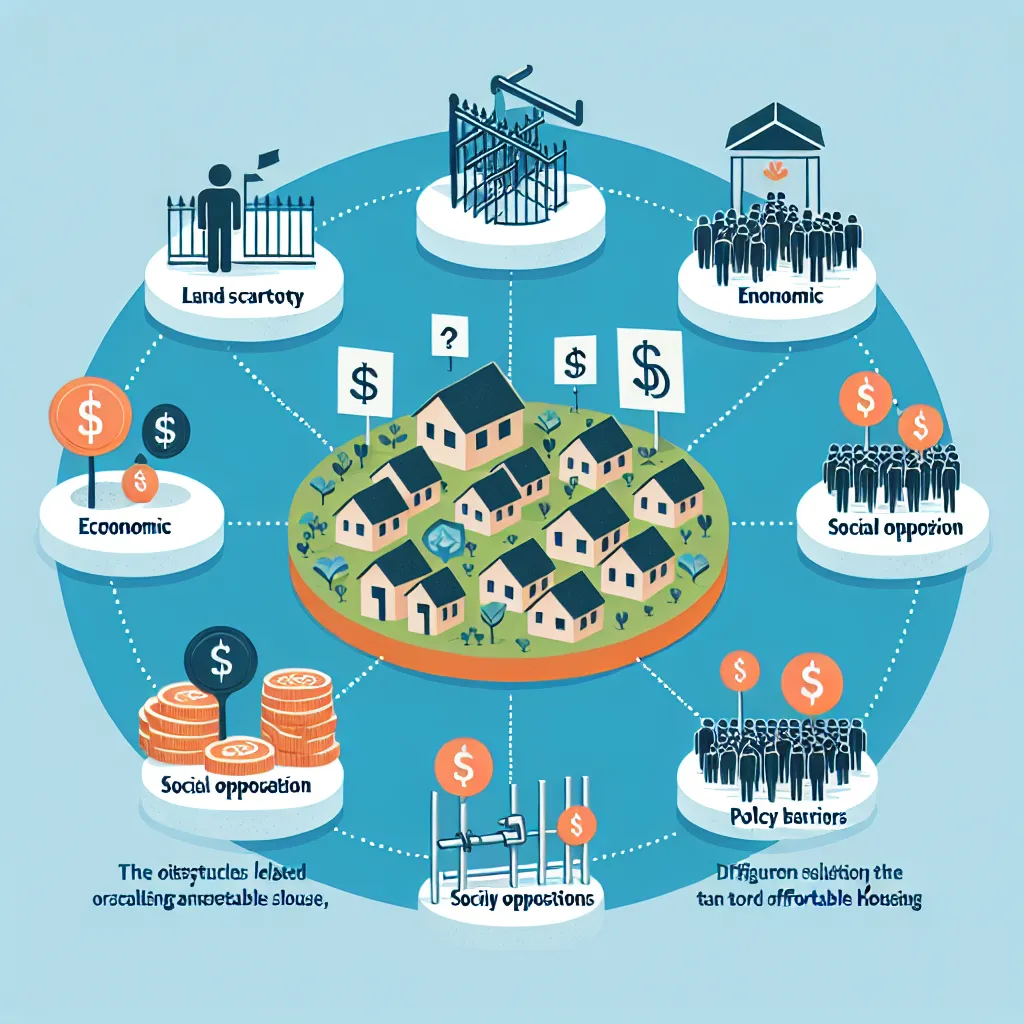The IELTS Reading section is a crucial component of the test, assessing your ability to comprehend complex texts and extract key information. Today, we’ll focus on a topic that has been increasingly prevalent in recent years: the challenges of providing affordable housing. This subject has appeared in various forms across multiple IELTS exams, making it a valuable area to explore for your preparation.
Based on our analysis of past IELTS exams and current global trends, we predict that this topic will continue to be relevant in future tests. The ongoing global housing crisis and rapid urbanization make it a pertinent issue for discussion in academic circles and, consequently, in IELTS Reading passages.
Let’s dive into a practice Reading passage on this subject, followed by questions and detailed explanations to help you hone your skills.
Reading Passage: The Affordable Housing Conundrum
The Growing Challenge
In cities across the globe, the provision of affordable housing has become an increasingly complex and pressing issue. As urban populations swell and property prices soar, governments and policymakers grapple with the multifaceted challenge of ensuring adequate, affordable housing for all citizens. This struggle is not merely about constructing more buildings; it encompasses a wide range of interconnected factors that make the problem particularly intractable.
One of the primary obstacles in providing affordable housing is the scarcity of suitable land in urban areas. As cities expand, available land becomes a premium commodity, driving up costs and making it difficult for developers to create housing that remains within reach of low and middle-income earners. This land crunch is exacerbated by zoning laws and building regulations that often restrict the types and density of housing that can be built in certain areas.
Economic and Social Factors
The economic dynamics of housing markets present another significant hurdle. In many cities, housing has become an attractive investment option, leading to speculation and inflated prices. This trend can price out local residents and create a mismatch between housing supply and genuine demand for affordable living spaces. Furthermore, the cost of construction materials and labor has been on an upward trajectory, adding to the overall expense of housing development.
Social factors also play a crucial role in the affordable housing equation. The “Not In My Back Yard” (NIMBY) phenomenon, where existing residents oppose new affordable housing developments in their neighborhoods, can create political and social barriers to housing projects. This resistance often stems from concerns about property values, increased traffic, or changes to neighborhood character.
Policy Challenges and Innovations
Policymakers face the daunting task of balancing various interests while addressing the housing affordability crisis. Implementing effective policies requires navigating a complex web of stakeholders, including developers, current residents, potential homebuyers, and advocacy groups. Strategies such as inclusionary zoning, which requires developers to include a certain percentage of affordable units in new projects, have shown promise but also face criticism and legal challenges in some jurisdictions.
Innovative approaches to tackle the affordable housing challenge are emerging. Some cities are experimenting with modular construction techniques to reduce building costs and time. Others are exploring community land trusts, where land is held in trust for the benefit of the community, helping to preserve affordability in the long term. Additionally, there’s growing interest in adaptive reuse projects, which convert non-residential buildings into affordable housing units.
The Way Forward
Addressing the affordable housing crisis requires a multifaceted approach that goes beyond simply building more units. It necessitates a reimagining of urban planning, innovative financing models, and a shift in how we view housing as a society. Collaboration between public and private sectors, along with community engagement, will be crucial in developing sustainable solutions.
As cities continue to grow and evolve, the challenge of providing affordable housing will remain at the forefront of urban policy discussions. The solutions developed today will shape the livability and sustainability of our cities for generations to come. The complexity of this issue underscores the need for creative, adaptable, and inclusive approaches to ensure that affordable housing becomes a reality for all who need it.
 Affordable Housing Challenges
Affordable Housing Challenges
Questions
True/False/Not Given
- The scarcity of urban land is the only factor contributing to the affordable housing crisis.
- Housing speculation can lead to inflated prices in urban areas.
- The NIMBY phenomenon always results in the cancellation of affordable housing projects.
- Inclusionary zoning policies have been universally successful in providing affordable housing.
- Modular construction techniques are being explored as a potential solution to reduce housing costs.
Matching Headings
Match the following headings to the paragraphs in the passage:
A. Innovative Solutions to the Housing Crisis
B. The Complexity of Urban Land Use
C. Social Resistance to Affordable Housing
D. The Global Nature of the Housing Problem
E. Economic Challenges in Housing Markets
F. The Need for Collaborative Approaches
- Paragraph 2
- Paragraph 3
- Paragraph 4
- Paragraph 5
- Paragraph 6
Multiple Choice
-
According to the passage, which of the following is NOT mentioned as a factor contributing to the affordable housing challenge?
A) Zoning laws
B) Cost of construction materials
C) Climate change
D) Land scarcity -
The NIMBY phenomenon refers to:
A) A type of affordable housing
B) Opposition to new housing developments in one’s neighborhood
C) A government policy on housing
D) A construction technique -
Which of the following is described as an innovative approach to affordable housing?
A) Increasing property taxes
B) Building more luxury apartments
C) Community land trusts
D) Restricting urban growth
Answer Key and Explanations
-
False – The passage mentions multiple factors, including land scarcity, economic dynamics, and social factors.
-
True – The passage states, “housing has become an attractive investment option, leading to speculation and inflated prices.”
-
Not Given – While NIMBY is described as a barrier, the passage doesn’t state that it always results in project cancellation.
-
False – The passage mentions that inclusionary zoning has “shown promise but also face criticism and legal challenges.”
-
True – The passage states, “Some cities are experimenting with modular construction techniques to reduce building costs and time.”
-
B – This paragraph discusses the scarcity of land and zoning laws affecting urban development.
-
E – This paragraph focuses on economic factors like housing speculation and construction costs.
-
C – This paragraph describes the NIMBY phenomenon and social resistance to affordable housing.
-
A – This paragraph discusses innovative approaches like modular construction and community land trusts.
-
F – This paragraph emphasizes the need for collaboration between various sectors to address the housing crisis.
-
C – Climate change is not mentioned in the passage as a factor contributing to the affordable housing challenge.
-
B – The passage defines NIMBY as “where existing residents oppose new affordable housing developments in their neighborhoods.”
-
C – Community land trusts are mentioned as an innovative approach to preserving housing affordability.
Common Mistakes to Avoid
- Overlooking key phrases: In True/False/Not Given questions, pay close attention to absolute terms like “only” or “always.”
- Misinterpreting implied information: Be careful not to infer information that isn’t explicitly stated in the passage.
- Failing to match headings accurately: Ensure you understand the main idea of each paragraph before matching headings.
- Choosing answers based on prior knowledge: Stick to the information provided in the passage, even if you have external knowledge about the topic.
Key Vocabulary
- Affordable housing: /əˈfɔːdəbəl ˈhaʊzɪŋ/ (noun) – Housing that is deemed affordable to those with a median household income.
- Urbanization: /ˌɜːbənəˈzeɪʃən/ (noun) – The process of making an area more urban.
- Speculation: /ˌspekjəˈleɪʃən/ (noun) – The buying of something in the hope that it will become more valuable at a future date.
- NIMBY: /ˈnɪmbi/ (acronym) – “Not In My Back Yard,” referring to opposition by residents to nearby developments.
- Inclusionary zoning: /ɪnˈkluːʒənəri ˈzəʊnɪŋ/ (noun) – A policy that requires a given share of new construction to be affordable by people with low to moderate incomes.
Grammar Focus
Pay attention to the use of complex sentences in academic writing. For example:
“Implementing effective policies requires navigating a complex web of stakeholders, including developers, current residents, potential homebuyers, and advocacy groups.”
This sentence uses a gerund phrase as the subject (“Implementing effective policies”) followed by a main clause that includes a list. Practice identifying and constructing similar complex sentences to improve your writing skills.
Tips for IELTS Reading Success
- Time management is crucial. Allocate your time wisely across all sections of the Reading test.
- Skim the passage quickly before answering questions to get a general idea of its content and structure.
- For True/False/Not Given questions, look for specific evidence in the text. Don’t make assumptions based on general knowledge.
- In Matching Headings exercises, focus on the main idea of each paragraph rather than specific details.
- For Multiple Choice questions, eliminate obviously incorrect options to increase your chances of selecting the correct answer.
- Practice regularly with a variety of texts on different topics to improve your reading speed and comprehension.
Remember, success in IELTS Reading comes from a combination of strong vocabulary, effective time management, and practiced reading strategies. Keep refining these skills, and you’ll see improvement in your performance.
For more practice on IELTS Reading and tips on tackling urbanization and housing challenges, visit our website. You can also explore related topics such as managing overpopulation to broaden your knowledge base for the IELTS exam.


